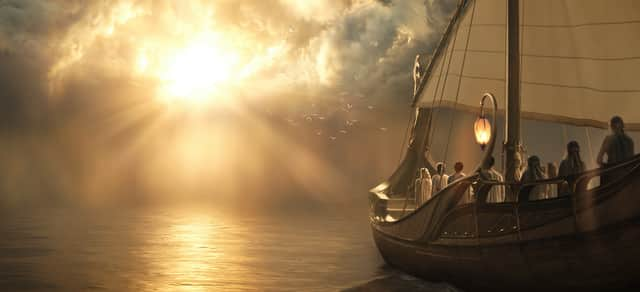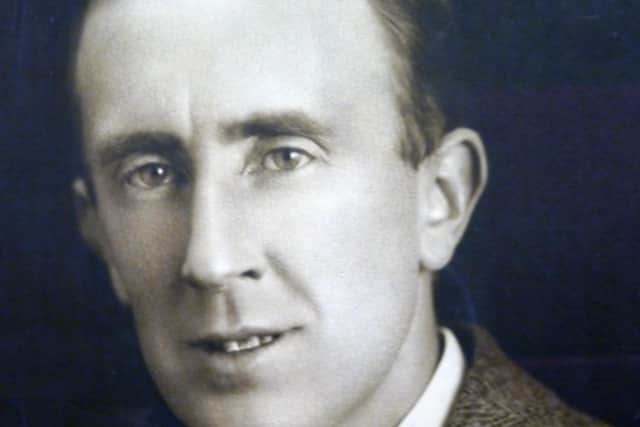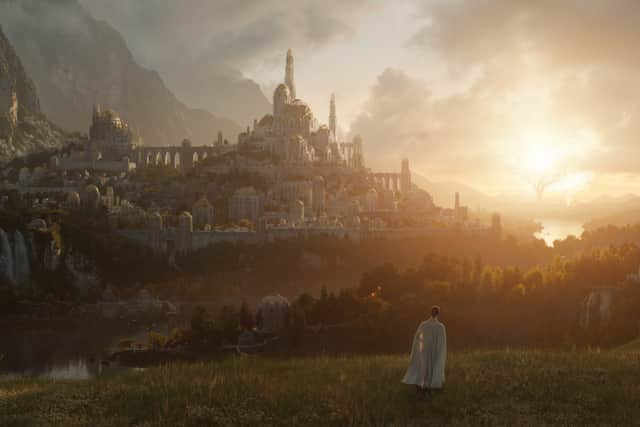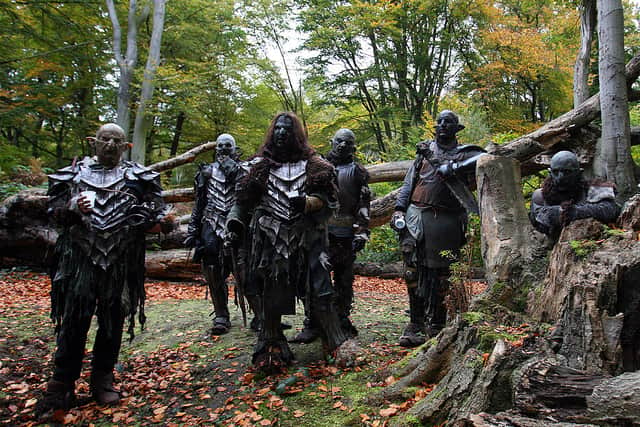JRR Tolkien: who was Lord of the Rings author, what books did he write, where did he study, who are family?
and live on Freeview channel 276
Stars and creators of the ambitious new Lord of the Rings: The Rings of Power series say J.R.R. Tolkien’s writing is "at the base of" the fantasy show.
The epic saga, which starts streaming Thursday (1 September) on Amazon Prime, is the latest highly anticipated journey to Middle-earth. Its $500 million budget for the first season makes it the most expensive TV series in history.


Advertisement
Hide AdAdvertisement
Hide AdTwo of Tolkien’s novels — The Lord of the Rings and The Hobbit — are among the top 10 bestselling novels of all time. Peter Jackson’s original film trilogy, which concluded with the Oscar-winning The Return of the King, grossed nearly $3 billion.
Showrunner and Executive Producer J. D. Payne said: “It really is a fantastic thing as a creator as we always have Tolkien at the base of what we are doing”.
Here is everything you need to know about the author, and his incredible body of work:
Who was J. R. R. Tolkien?
John Ronald Reuel Tolkien, who lived from 1892 to 1973, took fantasy in a new direction by emphasising what can happen when diverse characters unite for the greater good.
Advertisement
Hide AdAdvertisement
Hide AdHis own early life was marked by loss. Born in Bloemfontein, South Africa, on 3 January, 1892, Tolkien lost his father at age four. Life in industrial Birmingham, England, contrasted dramatically with his exotic birthplace.
When the family converted to Catholicism, a faith that Tolkien followed throughout his life, relationships with his extended family suffered. When he was 12-years-old, his mother died of diabetes. At 16, Tolkien met Edith Bratt, a fellow orphan who would later become his wife, but his guardian, Father Francis Morgan, ordered him not to see her until his 21st birthday.
Tolkien earned a scholarship to Oxford University and enrolled in 1911, where he studied English language and literature. In 1915, he completed his studies passing with first-class honours, and on 22 March, 1916, he and Edith were married.


The First World War had broken out on the continent while Tolkien was at Oxford, and after graduation, he took up his commission in the Lancashire Fusiliers. He survived the Battle of the Somme, one of the harshest battles of World War I, and returned to England suffering from trench fever. Millions of young men, including many of Tolkien’s boyhood friends, did not come home.
Advertisement
Hide AdAdvertisement
Hide AdTolkien’s first job after the war was researching word origins for the Oxford English Dictionary. He soon found a position as Reader of English language at the University of Leeds in 1920, and in 1924, the university appointed him Professor. In 1925, he returned to Oxford University as Professor of Anglo-Saxon at the remarkably young age of 33. In 1945, he became Merton Professor of English Language and Literature at Oxford, and he continued in that position until his retirement.
Tolkien and his wife, Edith, had four children: sons John, Michael, and Christopher and daughter Priscilla, born between 1917 and 1929. It was Christopher, however, who followed in his father’s footsteps as a university lecturer, also overseeing Tolkien’s literary estate and has edited many volumes of his father’s notes.
One of his close friends happened to be C.S. Lewis, who wrote The Chronicles of Narnia. For many years, they convened at least once a week to read both their favourite literature and their own works in progress. This group became the first critical audience for The Hobbit and The Lord of the Rings.
From a young age, Tolkien actively pursued a life of imagination by playing out scenes with his brother. He also added to his early mastery of Greek, Latin, Gothic, and Finnish, a talent for inventing languages of his own.


Advertisement
Hide AdAdvertisement
Hide AdBy the time he returned from the War, he had begun an ambitious collection of loosely connected stories, poems, and songs that told the history and legends of the elves, eventually known as The Silmarillion. After his children were born, he began enthusiastically telling them stories, many of which he wrote down.
While grading papers during a summer holiday in a bid to supplement his teacher’s salary, he fortuitously wrote down on a piece of paper the famous opening lines of his book: "In a hole in the ground there lived a hobbit." In 1937, the story was published by Allen and Unwin as The Hobbit. Much to Tolkien’s surprise, The Hobbit became a successful children’s book, receiving favourable reviews on both sides of the Atlantic.
It took him another 17 years to write The Lord of the Rings, which was published in three volumes in 1954 and 1955. The books received mixed reviews, ranging from the glowing words of C.S. Lewis and poet W.H. Auden, to a complete dismissal by American writer Edmund Wilson.
When a pirated Ace paperback edition in 1965 propelled the novels to cult status, the 73-year-old Tolkien had found himself in a remarkable position of being both hailed as a symbol, and adored by countless readers. Tolkien died in 1973, but his name lives through the millions who read his books worldwide.
What inspired J. R. R. Tolkien’s books?
Advertisement
Hide AdAdvertisement
Hide AdThere are echoes of the Somme throughout many of Tolkien’s stories about war and death. Mordor, the realm and base of the evil Sauron, has been compared to the devastated battlefields of the war. The author himself reportedly detested the reduction of the individual will and personality that soldiers experienced through their training and wartime experiences. To him, they were believed to be expendable in a massive collision of bureaucratic machines.


The “machine”, to Tolkien, was all that civilization uses to crush and confine the will of the individual. The author wrote the character of Saruman, an evil white wizard in The Lord of the Rings series, saying: “The old world will burn in the fires of industry. Forests will fall. A new order will rise. We will drive the machine of war with the sword and the spear and the iron fist of the orc.” The struggle to free the world from the domination of dark overlords who wanted to enslave all thinking, rational creatures became a common theme in Tolkien’s Middle-earth stories.
What else did J. R. R. Tolkien write?
Apart from The Hobbit, several shorter works by Tolkien appeared during his lifetime. The Lord of the Rings was not written as a trilogy, though it is often published in three parts: The Fellowship of the Ring, The Two Towers, and The Return of the King.
His shorter works included:
- Farmer Giles of Ham (1949)
- The Adventures of Tom Bombadil and Other Verses from the Red Book (1962)
- Poetry related to The Lord of the Rings
- Tree and Leaf (1964), with the seminal lecture “On Fairy-Stories” and the tale “Leaf by Niggle”
- Smith of Wootton Major (1967)
What did Christopher Tolkien write?
Tolkien in his old age failed to complete The Silmarillion, the “prequel” to The Lord of the Rings, and left it to his youngest son, Christopher, to edit and publish in 1977. Subsequent study of his father’s papers led Christopher to produce:
- Unfinished Tales of Númenor and Middle-earth (1980)
- The History of Middle-earth, 12 vol. (1983–96)
- The Children of Húrin - Narn I Chin Hurin: The Tale of the Children of Hurin (2007)
- Beren and Lúthien (2017)
- The Fall of Gondolín (2018)
Follow us on Twitter @nationalworldTV for updates on TV and streaming news.
Comment Guidelines
National World encourages reader discussion on our stories. User feedback, insights and back-and-forth exchanges add a rich layer of context to reporting. Please review our Community Guidelines before commenting.
